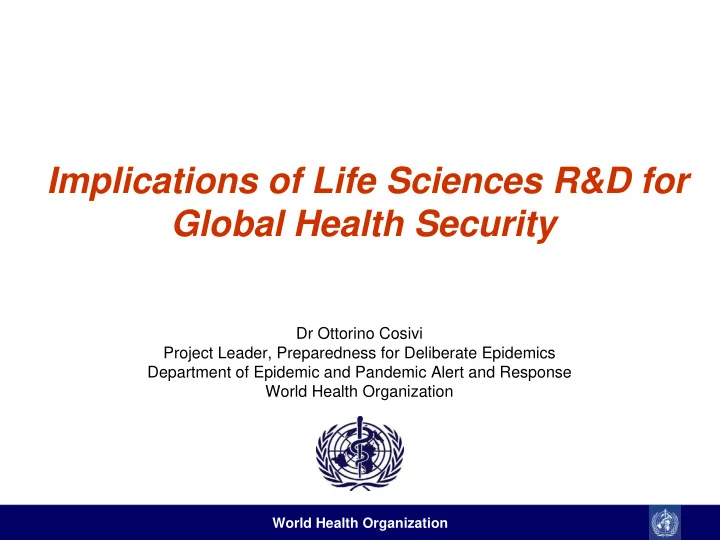

Implications of Life Sciences R&D for Global Health Security Dr Ottorino Cosivi Project Leader, Preparedness for Deliberate Epidemics Department of Epidemic and Pandemic Alert and Response World Health Organization World Health Organization
WHO’s Public Health Mandate • WHO Constitution of 1948 • International Health Regulations (2005) – “ public health emergency of international concern ” • World Health Assembly resolution 55.16 (2002) – "Global public health response to natural occurrence, accidental release or deliberate use of biological and chemical agents or radionuclear material that affect health” • World Health Assembly resolution 58.29 (2005) – "Enhancement of laboratory biosafety" World Health Organization
Actions taken on Events From January 2001 to December 2005 WHO has verified 949 events fulfilling the criteria of Public Health Emergency of International Concern World Health Organization
Bio-Risks from laboratory accidents • SARS, Singapore, 2003 • SARS, Taiwan, 2003 • SARS, China, 2004 • Tularaemia, USA, 2004 • Ebola, Russian Federation, 2004 World Health Organization
Bio-Risks from deliberate use • Low probability, high consequence • New technology ( biotechnology and genetic engineering) • The Biological Weapons Convention has provisions for assistance in case of attack or threat of attack, but there are no organization/capacities World Health Organization
Bio-Risk Reduction Prevention Preparedness Event Event Response Recovery World Health Organization
Bio-Risk Reduction Prevention Preparedness Response Recovery World Health Organization
Epidemic Outbreak alert and Intelligence response operations Epidemiological Verification Public Health Response Follow-up World Health Organization
Bio-Risk Reduction Preparedness Prevention Recovery Response World Health Organization
Global Laboratory Networks Directory • Identify and link assets of public health, •KNOW YOUR NEIGHBOR molecular typing and high consequence agent laboratory networks •COLLABORATION • Develop a benefits package for networks such as training on biosafety, standardized •CAPACITY BUILDING templates, protection of intellectual property • Coordinated multi-center studies to encourage working together and developing surge capacity World Health Organization
WHO Global Surveillance System for Human Influenza 1 laboratory Annual output � 1 laboratory � ~175 000–220 000 samples national network � 15 000–40 000 isolates � 2 000–10 000 viruses characterized World Health Organization
WHO guidance for public health preparedness • Health aspects of chemical and biological weapons . Report of a WHO group of consultants (1970) • Public health response to biological and chemical weapons: WHO guidance (2004) • Managing the health risks of the deliberate use of biological and chemical agents or radioactive material: guidance on capacity assessmen t (being finalized) World Health Organization
Managing risks to public health posed by the deliberate use of biological agents Prevention Preparedness Recovery Response World Health Organization
WHO Biosafety Programme • Laboratory Biosafety Manual , 3 rd Edition (2004) • Laboratory Biosecurity Guidelines (being finalized) • Coordination of global Biosafety networks – WHO Biosafety Advisory Group (BAG) • UN Model Regulations – Transport of infectious substances • Visits to the smallpox repositories laboratories World Health Organization
The implications of life science R&D for global health security The Objective is to raise awareness 1. Importance of health research 2. Risks posed by misuse of valuable research and materials World Health Organization
The implications of life science R&D for global health security Phase 1 (completed): – background paper (available on the web) – international network of individuals and institutions World Health Organization
The implications of life science R&D for global health security Phase 2 (being started): milestones – Study Group – Web platform for project feedback • Your view/advice is welcomed ! – Regional Workshops – Project report(s) World Health Organization
The need for a global partnership • Global Outbreak Alert and Response Network • More than 100 CBW experts from all WHO regions which have contributed to the 2nd edition of the Public health response to biological and chemical weapons: WHO guidance • Informal network of individuals with expertise on CBW-related issues • Biosafety Advisory Group (BAG) • Disease specific laboratory and expert networks (anthrax, tularaemia, smallpox) • Other International Organizations, e.g. FAO, IAEA, ICGEB, OIE, OPCW, UN, UNICRI, etc. • Last, but not least, we are grateful for the support of Sloan Foundation, Nuclear Threat Initiative (NTI) and Australian, Canadian, Italian, Swiss and US Governments, and others World Health Organization
Recommend
More recommend